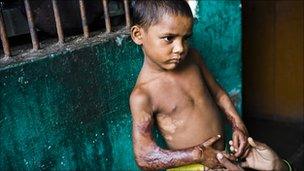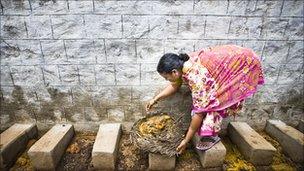Indian Dalits' suffering laid bare by photographer
- Published
Dalits make up more than 16% of India's population of one billion. Yet, despite years of campaigning and state intervention, many of them still face discrimination in society. Their hardship has been highlighted at an exhibition in London.
A little girl leans against a stained turquoise concrete wall.
You first notice her face, which appears deep in thought - then your eyes are drawn to the horrific scars on her arms and body.
This is just one of the photographs on display at Being Untouchable, an exhibition at London's HOST Gallery exploring the lives of Dalits in India.
The little girl is Kamlesh. She was just seven when she was pushed on to a pile of burning rubbish as she was walking with her mother.
Kamlesh is a Dalit, and her scars are a constant reminder of the "punishment" she received for using a road reserved for "high-caste" people.
According to Christian Solidarity Worldwide (CSW), the charity that organised the exhibition, the bulk of caste-based discrimination and violence in India goes unrecorded.

Kamlesh was pushed on to a pile of burning rubbish for walking on the "wrong" road
But in 2008 alone, there were 33,000 reports of crimes against Dalits in official statistics, it says.
Formerly known as Untouchables, members of the Dalit community were considered to be the lowest in the traditional Hindu caste system.
The images are presented in such a way that the viewers will feel encouraged to touch them, says Marcus Perkins, the photographer behind the exhibition.
"Despite the huge numbers affected, I'm convinced many outside India either don't know about casteism, or think it is just dying out as a result of India's economic boom, which clearly is not the case," he says.
There are about 166 million Dalits in India, which means one in every 40 people in the world is a Dalit.
Discrimination on the basis of caste is illegal in India, but campaigners say it still continues and is particularly widespread in rural areas.
Meena Kandasamy, an Indian Dalit activist and writer attended the launch of the exhibition. "You realise this is something you should work on, something that has to be changed," she tells the BBC World Service, adding that continuing discrimination against Dalits challenged the idea of an equal world.
"It challenges your idea of hope and justice. It challenges your idea of any good future for the country," she says.
Low-end jobs
The aim of the exhibition is to use the photographs to show different forms of "untouchability", discrimination that affects Dalits in modern India, says David Griffiths of CSW.
"In our preoccupation with the extraordinary rise of a middle-class in India, we must not allow these voices to be drowned out," he says.
One photograph on display shows a woman called Uma cleaning the communal latrine of her village by hand.

Uma, a Dalit woman, cleans human excrement by hand from a latrine
Members of the Dalit community are frequently forced to take on some of the most demeaning and low-end jobs, whilst lack of opportunities for better work means they often live in severe poverty.
Another image shows Dalit families sleeping together in a community centre after their homes were looted and burnt during a surge in caste-related violence.
Mr Griffiths believes India has much to gain by dealing with the issue of untouchability and tackling the discrimination that Dalits still face.
"Fairer distribution of wealth and universal access to education in the country would mean a larger workforce capable of contributing to India's booming private sector.
"There's a real self-interest here for India to address caste discrimination," he says.
- Published14 September 2010
- Published24 September 2010